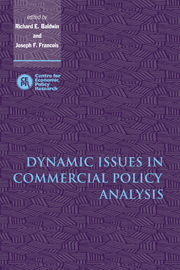Book contents
- Frontmatter
- Contents
- List of figures
- List of tables
- Preface
- List of conference participants
- 1 Introduction
- 2 Transition dynamics and trade policy reform in developing countries
- 3 Putting growth effects in computable equilibrium trade models
- 4 Innovation, capital accumulation, and economic transition
- 5 Multinational production, skilled labour, and real wages
- 6 Economic policy and the manufacturing base: hysteresis in location
- 7 Trade liberalization and investment in a multilateral framework
- 8 Investment creation and investment diversion: simulation analysis of the Single Market programme
- 9 Blueprints, spillovers, and the dynamic gains from trade liberalization in a small open economy
- 10 Trade policy and North–South migration
- 11 Long-term modelling of trade and environmental linkages
- 12 Labour markets and dynamic comparative advantage
- Index
11 - Long-term modelling of trade and environmental linkages
Published online by Cambridge University Press: 13 January 2010
- Frontmatter
- Contents
- List of figures
- List of tables
- Preface
- List of conference participants
- 1 Introduction
- 2 Transition dynamics and trade policy reform in developing countries
- 3 Putting growth effects in computable equilibrium trade models
- 4 Innovation, capital accumulation, and economic transition
- 5 Multinational production, skilled labour, and real wages
- 6 Economic policy and the manufacturing base: hysteresis in location
- 7 Trade liberalization and investment in a multilateral framework
- 8 Investment creation and investment diversion: simulation analysis of the Single Market programme
- 9 Blueprints, spillovers, and the dynamic gains from trade liberalization in a small open economy
- 10 Trade policy and North–South migration
- 11 Long-term modelling of trade and environmental linkages
- 12 Labour markets and dynamic comparative advantage
- Index
Summary
Introduction
Trade and environment linkages are coming under increasing scrutiny and a considerable literature is emerging on the subject. Some papers have looked formally at coordination of policies toward the environment and trade in a polluted open economy. These include Markusen (1975), Baumol and Oates (1988), Krutilla (1991), and Choi and Johnson (1992). With the exception of Copeland (1994), however, they emphasize optimal interventions and abstract from the more practical issues of designing second-best and piecemeal reforms. Copeland investigated piecemeal trade and environmental policy reforms in a small, open, production-polluted, and distorted economy and identified sufficient conditions for welfare enhancement. This approach initiated an important new line of thinking in the literature on second-best trade reform, following Hatta, because it addressed the problem of coordination of trade and environment policies. It also identified situations in which a tariff can be used to abate pollution without decreasing welfare.
Building on these results, we account for pollution in consumption as well as production activities and let firms use two approaches to pollution abatement in production. Toxic effluents arising from final consumption are substantial, e.g. non-electrical energy, chemicals, and post-consumption waste materials. Consumption-induced pollution critically undermines tariffs as second-best instruments for environmental policy. Further, the presence of consumption-based pollution externalities complicates the welfare effects of trade liberalization and can defeat the intentions of narrower, production-oriented policies. On the production side, firms in polluting sectors can change output (effluent level) or technology (effluent intensity) in response to the policies considered.
- Type
- Chapter
- Information
- Dynamic Issues in Commercial Policy Analysis , pp. 345 - 366Publisher: Cambridge University PressPrint publication year: 1999



